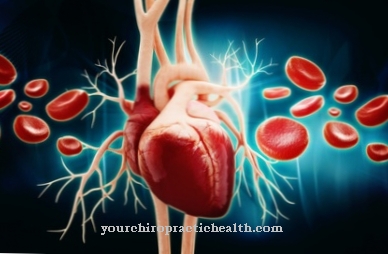Of the Energy metabolism of the body is characterized by the biochemical breakdown of high-energy organic starting compounds into low-energy inorganic compounds with the release of energy. This energy is needed to maintain biological processes. Furthermore, a distinction must be made between energy metabolism and building metabolism (anabolism).
What is the energy metabolism?

Every organism is subject to both energy and building metabolism. The energy metabolism is characterized by the release of energy to ensure the bodily processes. In contrast, the body's own proteins, nucleic acids, fats and carbohydrates are built up during the building metabolism.
Energy is necessary to maintain the biological processes. A living being has to supply energy from outside in order to exist at all. Plants convert solar energy through photosynthesis into the chemical energy of carbohydrates, fats and proteins. Animals and humans need the chemical energy of these substances to support life.
Mainly carbohydrates and fats are used for energy production. Amino acids and proteins also have a high energy content. However, they are mainly needed to build the body.
The energy metabolism of humans secures the basal metabolic rate and the output metabolism. The basal metabolic rate includes the energy metabolism for all vital energetic processes that are necessary in a complete state of rest. The performance conversion describes the additional energy consumption during physical exercise.
Function & task
On the one hand, human nutrition serves to maintain physical functions and to provide additional performance during physical activity. On the other hand, the body's own substances (proteins) are built up from the building blocks of nutrients (mainly proteins).
Carbohydrates and fats are the main sources of energy. Proteins can only be used to generate energy if there is insufficient food intake. This is the case, for example, in a state of hunger (starvation metabolism). However, it may also be necessary to generate energy from proteins as part of normal metabolism (with increased protein intake).
Carbohydrates serve as short-term energy suppliers. After a high-carbohydrate diet, blood sugar levels rise. As a result, there is an increased production of insulin. The insulin ensures that the blood sugar is distributed to the individual cells. There it is broken down into carbon dioxide and water as part of the energy metabolism. During this breakdown, the chemical energy stored in the carbohydrates is released to maintain the physical processes. When carbohydrates are burned, heat is generated and muscle activity is carried out.
Excess carbohydrates are stored as glucogen in the liver and muscles. Glucogen is a starchy complex carbohydrate. If the energy supply is too low, these carbohydrate stores are initially used to generate energy.
Other sources of energy are fats and fatty acids. Fats have an even higher energy content than carbohydrates. For example, one gram of sugar contains 4 kilocalories. In one gram of fat, however, there are already 9 kilocalories. Fats are responsible for the long-term energy supply. When the carbohydrates are used up, the fat stores are used to generate energy. Fats are usually the result of excess carbohydrates and fats. In the course of evolution, the organism has found a way to store stocks in the form of fat during periods of hunger. In times of abundance, more was consumed than was currently necessary to be able to store the excess energy.
Proteins can also serve as energy suppliers. For example, when the carbohydrate stores are used up, the body's own proteins are first broken down to an increased extent into amino acids. These are then converted into glucose as part of what is known as gluconeogenesis in order to maintain blood sugar levels.
Some physical processes initially only take place with the help of carbohydrates. The brain's activity depends on the supply of glucose. If the blood sugar level drops dangerously, it can lead to unconsciousness.
The body consumes energy even under extreme rest conditions. For example, body temperature must be kept constant. Furthermore, all vital processes such as heart activity, breathing or brain activity continue. The resting metabolic rate is different for every person. Usually men have a higher basal metabolic rate than women due to their larger muscle mass. It is usually 2000 to 2400 kilocalories in adults.
The performance turnover then results from the additional physical strain. Not only the additional movement consumes energy. The heart, breathing and other processes are also stimulated during physical activity and have a greater energy requirement.
Illnesses & ailments
If there are long-term imbalances in the energy metabolism, diseases can result. These diseases have their origin in a mismatch of energy needs and energy supply. In earlier times (and sometimes still in other parts of the world) there were many deaths as part of periods of starvation.The energy demand could not be met because there was not enough food available. When the energy reserves built up by the body were used up, the organism had to fall back on the body's own proteins in the form of muscles. When these were almost used up, the organs themselves were also broken down, which ultimately led to multiple organ failure.
There is currently another circumstance which, while not causing death as quickly, can lead to serious illness. The food supply in abundance nowadays often leads to overeating. More calories are consumed than consumed. The result is an increased storage of body fat, which in the long term can lead to diseases such as diabetes mellitus, arteriosclerosis or cardiovascular diseases with all their consequences. In addition to these diseases, the number of rheumatic diseases and cancer is also increasing. To avoid civilization diseases of this kind, a healthy lifestyle with plenty of exercise and a balanced diet is recommended.












.jpg)



.jpg)










.jpg)
